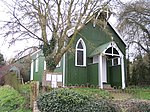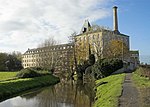Fretherne Court
Fretherne Court was a handsome residential sporting mansion with picturesque grounds and deer park estate of some 676 acres, situated in the Severn Vale between the Gloucester and Sharpness Canal and the River Severn, in Fretherne, Gloucestershire. It was owned by the Darell family who were Baronets of Richmond Hill.It was built in around 1864 by Sir Edward Tierney (Tierney baronets) who also enlarged Fretherne church from one aisle to three. A good description of Sir Edwards renovations can be read in Sir Lionel E. H. M. Darell's memoirs - written about 1950: "My grandfather - Rev. Sir Lionel William Darell, 4th Baronet (1817–1883) - had come from Richmond Hill, London to a little village of Fretherne, the living being presented to him by Sir Edward Tierney. Sir Edward completely transmogrofied the humble little refectory of Fretherne, building on to it many extra reception rooms, a ballroom, billiard room, water towers and halls, and last but no means least, a charming little chapel just inside the front entrance hall. Our airey nurseries were on the second floor, but in those days there was no electric light, central heating, or bathroom of any description. The Kitchens were large, designed after the big kitchen at Christ Church, Oxford, but the food had to be brought up many passages".
Excerpt from the Wikipedia article Fretherne Court (License: CC BY-SA 3.0, Authors).Fretherne Court
Arlingham Road,
Geographical coordinates (GPS) Address Nearby Places Show on map
Geographical coordinates (GPS)
| Latitude | Longitude |
|---|---|
| N 51.7813 ° | E -2.3852 ° |
Address
Arlingham Road
Arlingham Road
GL2 7JF , Fretherne with Saul
England, United Kingdom
Open on Google Maps







